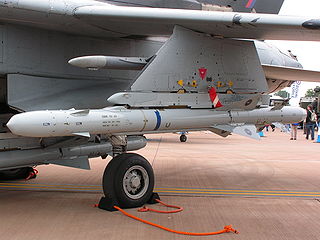 W
WAn anti-radiation missile (ARM) is a missile designed to detect and home in on an enemy radio emission source. Typically, these are designed for use against an enemy radar, although jammers and even radios used for communications can also be targeted in this manner.
 W
WAGM-45 Shrike is an American anti-radiation missile designed to home in on hostile anti-aircraft radar. The Shrike was developed by the Naval Weapons Center at China Lake in 1963 by mating a seeker head to the rocket body of an AIM-7 Sparrow. It was phased out by U.S. in 1992 and at an unknown time by the Israeli Air Force, and has been superseded by the AGM-88 HARM missile. The Israel Defense Forces developed a version of the Shrike that could be ground-launched with a booster rocket, and mounted it on an M4 Sherman chassis as the Kilshon.
 W
WThe AGM-78 Standard ARM was an anti-radiation missile developed by General Dynamics, United States.
 W
WThe AGM-88 HARM is a tactical, air-to-surface anti-radiation missile designed to home in on electronic transmissions coming from surface-to-air radar systems. It was originally developed by Texas Instruments as a replacement for the AGM-45 Shrike and AGM-78 Standard ARM system. Production was later taken over by Raytheon Corporation when it purchased the defense production business of Texas Instruments.
 W
WThe AGM-122 Sidearm was an American air-to-surface anti-radiation missile produced between 1986 and 1990. While not as capable as newer anti-radiation missiles, they were cheaper and lighter in weight allowing more versatile deployment.
 W
WALARM is a British anti-radiation missile designed primarily to destroy enemy radars for the purpose of Suppression of Enemy Air Defenses (SEAD). It was used by the RAF and is still used by the Royal Saudi Air Force. The weapon was retired by the UK at the end of 2013.
 W
WThe Martel is an Anglo-French anti-radiation missile (ARM). The name Martel is a contraction of Missile, Anti-Radiation, Television, referring to the guidance options. There are two variants, the passive radar guided and the video guided.
 W
WThe Sky Sword II, or TC-2, is a medium-range, radar guided air-to-air missile. It has an inertial navigation system, a data-link for mid-course guidance and active radar homing for terminal guidance, beyond visual range. It also has ECCM capability and can engage multiple targets. According to Su Tzu-yun, Chief Executive Officer at the Center for Advanced Technology at Tamkang University, they are a cost-effective design which can perform a key role in Taiwan's defense strategy, and substantially offset China’s air superiority. Some details of its design were revealed for the first time at the Paris Air Show in 2015. The pulse doppler radar seeker reportedly has a detection range of 9.3km.